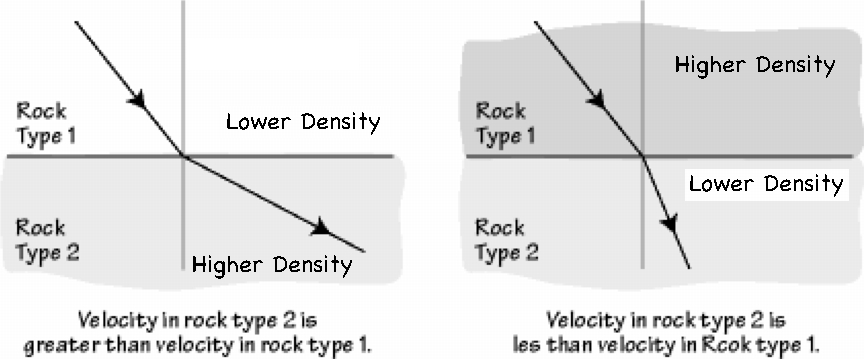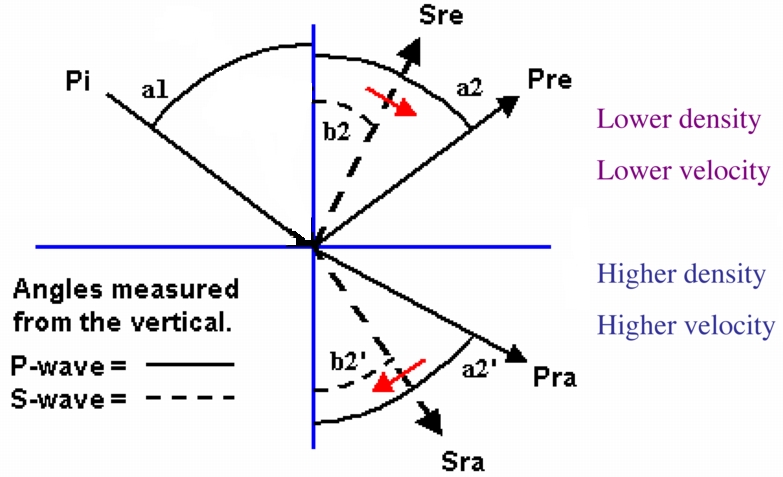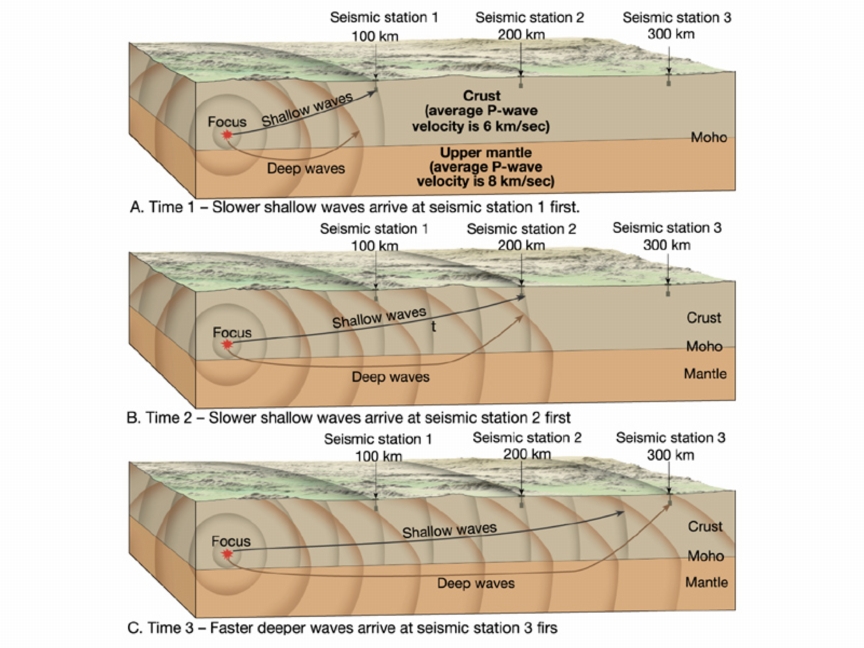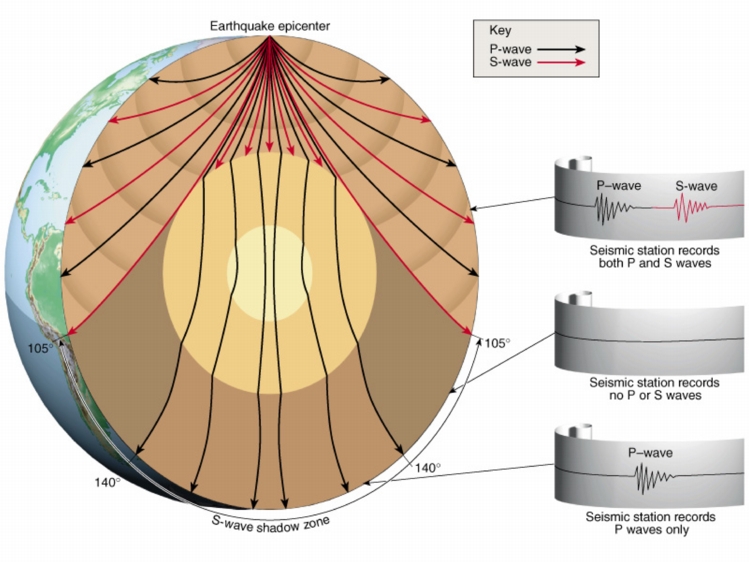The Earth's Interior
Size of Earth:
Polar Radius = 6356.75km
Equatorial Radius = 6378.14km
Rotation about its spin axis causes the earth to be a very slightly flattened sphere
There are two basic ways of dividing the Earth into layers: Chemical Compostion and Physical Properties
Chemical Composition
Compositional Sorting - Overall Density Sorting of the Earth, Iron and Nickel sink to the center - lighter elements float upwards. Called the "Iron Catastrophe"
Chemical differentiation - chemical affinities of elements for each other. Uranuium has an affinity for oxygen, not iron, so it formed compounds that were relatively light and rose up rather than sinking to the core.
Compositional Layered structure:
- Crust
- Continental (about 35 km thick; 60 km in mountain ranges)
Granitic composition (2.7 g/cm3)
Non-ferromagnesian minerals dominate
- Oceanic (about 5 km thick)
Basaltic composition (3.0 g/cm3)
Ferromagnesian minerals dominate
- Mantle (2885 km thick)
The mantle has the biggest volume of all the layers. It is primarily made up of Iron (Fe) and Aluminium (Al) rich silicate minerals (silicates are minerals made of Silicon (Si) and Oxygen (O) ).
Olivine (3.38 g/cc), Spinel (3.66 g/cc), Perovskite (4.27 g/cc)
Solid that flows; plastic behavior
- Core - chemically homogeneous (all the same)
Outer core (2270 km thick)
Molten Fe with some Ni
Inner core (1216 km radius)
Solid Fe with some Ni

Physical Properties - Mechanical Behavior
The layers are defined by their physical properties
With increasing depth, Earth's interior is characterized by gradual increases in temperature, pressure, and density
Depending on the temperature and depth, a particular Earth material may behave like a brittle solid, deform in a plasticÐlike manner, or melt and become liquid
Mechanical layers of Earth's interior are based on physical properties and hence mechanical strength
Mechanically Layered Structure
- Lithosphere (sphere of rock)
Earth's outermost layer
Consists of the crust and uppermost mantle
Relatively cool, rigid shell (BRITTLE)
Averages about 100 kilometers in thickness, but may be 250 kilometers or more thick beneath the older portions of the continents
- Asthenosphere (weak sphere)
Beneath the lithosphere, in the upper mantle to a depth of about 600 kilometers
Small amount of melting in the upper portion mechanically detaches the lithosphere from the layer below allowing the lithosphere to move independently of the asthenosphere
- Mesosphere or lower mantle
Rigid layer between the depths of 660 kilometers and 2900 kilometers
Rocks are very hot and capable of very gradual flow
- Outer core
Composed mostly of an iron-nickel alloy
Liquid layer
2270 kilometers (1410 miles) thick
Convective flow within generates EarthÕs magnetic field
- Inner core
Sphere with a radius of 3486 kilometers (2161 miles)
Material is stronger than the outer core
Behaves like a solid
So - How do we know this ?
- Drilling
Wells drilled into Earth are mostly in the upper 7 km of the crust. Deepest well is only a little under 8mi deep
- Volcanic activity
Xenoliths = foreign rock (pieces of the mantle in lava). Only useful to depth of about 200 km
- High pressure laboratory experiments
- Samples of the solar system (meteorites)
- Study of seismic waves generated by earthquakes and nuclear explosions. Seismic waves are one of the main keys used to understand the EarthÕs Interior
Important Notes
- Velocity depends on the density and elasticity of the transmitting material. The denser the material, the faster the waves travel. Crystalline rock transmits waves faster than mud.
- Pressure increases within the Earth - therefore density increases. The deeper inside the Earth the faster waves travel.
- P-waves travel in all mediums
- S-waves travel only in solids
- P-waves travel faster than S-waves
Seismic Energy
Wave energy gets reflected and refracted at seismic boundaries.
- Reflection
Waves will always reflect in such a way that the angle at which they approach the barrier equals the angle at which they reflect off the barrier.

- Refraction
refraction of waves involves a change in the direction of waves as they pass from one medium to another. Refraction, or bending of the path of the waves, is accompanied by a change in velocity and amplitude of the waves.

If the velocity of the rock increases below the boundary, the angle of refraction "bends" away from the vertical.
If the velocity of the rock decreases below the boundary, the angle of refraction "bends" toward the vertical.
Each time a seismic wave (a P or S wave) hits a boundary it breaks up into two reflected waves, a P-wave and a S-wave, and two refracted waves, a P-wave and a S-wave.

Major Layers
- Mohorovicic Discontinuity
Moho - discovered in 1909 - first convincing evidence for layering in the Earth.
He found that for stations located >200km away the average P-wave velocity was much faster

- Core-Mantle Boundary
Discovered in 1914 (Gutenberg)
P-waves die out between 105 degrees to 140 degrees away from the source of an earthquake
Created by bending the waves as the hit a boundary
S-waves die out entirely past 105 degrees

- Inner Core
1936 - by Lehmann
Discovered the solid inner core

Back to GES101 homepage







